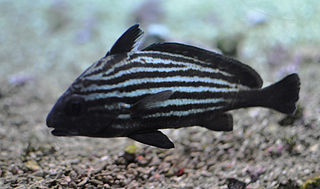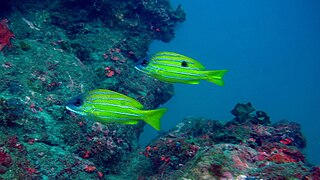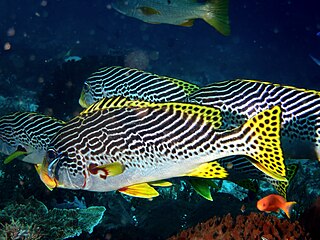
The goatfishes are fish of the family Mullidae, the only family in the order Mulliformes. The family is also sometimes referred to as the red mullets, which also refers more narrowly to the genus Mullus.

Latris lineata, the striped trumpeter, common trumpeter, copper moki, Hobart-town trumpeter, kokikohi, real trumpeter, Tasmanian striped trumpeter or Tasmanian trumpeter, is a species of marine ray-finned fish belonging to the family Latridae, the trumpeters. It is native to rocky reefs in the temperate oceans of the southern hemisphere.

The dash-and-dot goatfish is a species of goatfish native to the Indian and Pacific oceans.
The red mullets or surmullets are two species of goatfish, Mullus barbatus and Mullus surmuletus, found in the Mediterranean Sea, east North Atlantic Ocean, and the Black Sea. Both "red mullet" and "surmullet" can also refer to the Mullidae in general.

Cynoscion is a genus of marine ray-finned fishes belonging to the family, Sciaenidae, the drums and croakers. These fishes are found off the coasts of North and South America in the western Atlantic and eastern Pacific Oceans. Many fishes in this genus have been given the common name weakfish.

Coastal fish, also called inshore fish or neritic fish, inhabit the sea between the shoreline and the edge of the continental shelf. Since the continental shelf is usually less than 200 metres (660 ft) deep, it follows that pelagic coastal fish are generally epipelagic fish, inhabiting the sunlit epipelagic zone. Coastal fish can be contrasted with oceanic fish or offshore fish, which inhabit the deep seas beyond the continental shelves.

Pareques acuminatus, commonly known as the high-hat, donkeyfish, cubbyu, Steindachner's ribbonfish, streaked ribbonfish, striped ribbonfish or striped drum, is a species of marine ray-finned fish belonging to the genus Pareques in the family Sciaenidae, the drums and croakers. This species is found in the western Atlantic Ocean.

Upeneichthys vlamingii, the blue-spotted goatfish, southern goatfish, black-striped goatfish, blue-striped red mullet, southern red mullet or western red mullet, is a species of marine ray-finned fish, a goatfish from the family Mullidae native to the coast of southern Australia.

Upeneichthys is a genus of goatfishes native to the Indian and Pacific coasts of Australia.

Lutjanus quinquelineatus, the five-lined snapper, blue-striped snapper, blue-banded sea-perch, five-lined seaperch or gold-striped sea-perch, is a species of ray-finned fish, a snapper belonging to the family Lutjanidae. It is native to the Indian Ocean and the western Pacific Ocean.

Scorpaena papillosa, the red rock cod, Southern red scorpionfish, chained scorpionfish, common red gurnard, Southern red scorpioncod, Southern rockcod or dwarf scorpionfish, is a species of venomous marine ray-finned fish belonging to the family Scorpaenidae, the scorpionfishes.
Trypauchen vagina, commonly known as the burrowing goby, is a species of eel goby found in the Indo-Pacific region. It has an elongated body about 20 to 22 cm in length. It is reddish-pink in color and possesses distinctive pouches in the upper edges of its gill covers. It lives in burrows in the silty and muddy bottoms of its marine and brackish habitats. It has reduced eyes that are entirely covered with skin and the anterior portion of its head is protected by thick flesh. Both adaptations aid it in digging its burrows.

Parupeneus pleurostigma, commonly known as the sidespot goatfish and round-spot goatfish, is a marine fish belonging to the family Mullidae.

Lutjanus fulvus, the blacktail snapper, flametail snapper, redmargined seaperch, Waigeu snapper or yellowmargined sea perch, is a species of marine ray-finned fish, a snapper belonging to the family Lutjanidae. It is native to the Indo-West Pacific region. It is an important species for fisheries within its range.

Plectorhinchus lineatus, also known as the yellowbanded sweetlips, oblique-banded sweetlips, diagonal-banded sweetlips, Goldman's sweetlips, lined blubber-lips, lined sweetlips, many-lined sweetlips, striped sweetlips and yellowband sweetlips, is a species of marine ray-finned fish, a sweetlips belonging to the subfamily Plectorhinchinae, one of two subfamilies in the family Haemulidae, the grunts. It inhabits coral reefs of the western Pacific Ocean, where it occurs at depths from 1 to 35 m.

Upeneus moluccensis, the goldband goatfish, golden-banded goatfish or Moluccan goatfish, is a species of Indo-Pacific goatfish from the red mullet and goatfish family, the Mullidae. It is widespread in the warmer waters of the Indian and Pacific Oceans as far east as New Caledonia and has colonised the eastern Mediterranean Sea from the Red Sea via the Suez Canal, making it a Lessepsian migrant.

Parupeneus forsskali, common name Red Sea goatfish, is a species of goatfish belonging to the family Mullidae.

The tubemouth is a species of ray-finned fish, a weed whiting from the family Odacidae. It is endemic to the southern coatsts of Australia where it is camouflaged to live among beds of seagrass.
Mullus auratus, the red goatfish or northern goatfish, is a species of ray-finned fish, a goatfish from the family Mullidae which is native to the western Atlantic Ocean.
Upeneichthys stotti, Stott's goatfish, is a species of marine ray-finned fish, a goatfish from the family Mullidae. It is endemic to the eastern Indian Ocean off the coasts of Western Australia where it occurs in the inshore waters of the continental shelf. This species was described by J. Barry Hutchins in 1990 with a type locality given as north east of Rottnest Island and differentiated from Upeneichthys lineatus by differences in the snout pattern, fin proportions and smaller size. The specific name honours Chris Stoot, who as an honorary field assistant at the Western Australian Museum was involved in the collection of the paratypes.

















